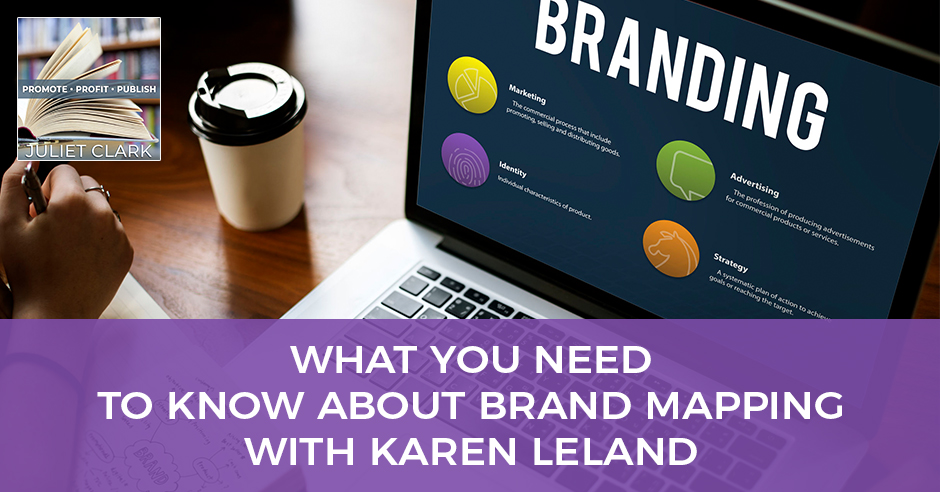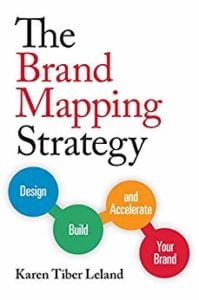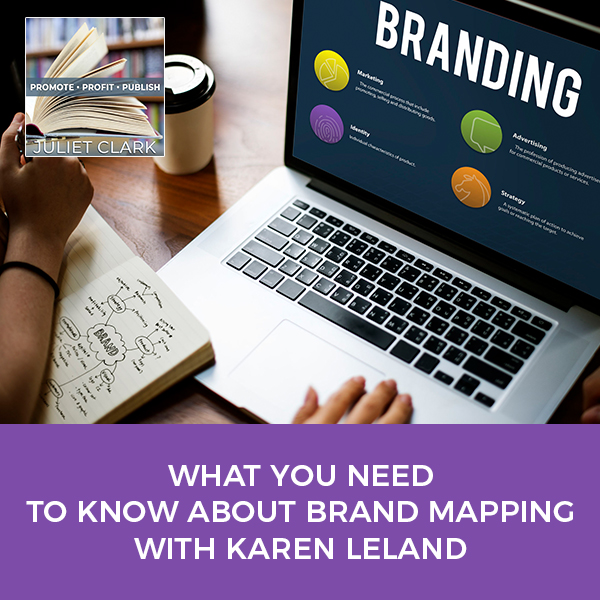
A lot of people think of branding as either the visuals or what we call the brand identity – the logo, the website, the colors, or the fonts. Some think of branding as an elevator pitch, their one or two-sentence thing they say about their brand. Karen Leland, founder of the branding and marketing strategy firm, Sterling Marketing Group, says both are an important part of your brand, but they’re just the tip of the iceberg. In her book, The Brand Mapping Strategy, Karen gives people all the under-parts of the iceberg and the ocean around it that is equally important for people to know about their brand in order to effectively design a strategy to start to put that into motion.
—
Watch the episode here:
Listen to the podcast here:
What You Need To Know About Brand Mapping with Karen Leland

The Brand Mapping Strategy: Design, Build, and Accelerate Your Brand
Our guest is Karen Leland. Karen is the Founder of Sterling Marketing Group. A branding and marketing strategy firm where she works with clients building a stronger personal team and business brands. She’s the author of nine bestselling books, one of which is The Brand Mapping Strategy. She sold more than 400,000 copies of her nine books. She’s also regularly featured as a writer for Inc.com, Forbes.com, Entrepreneur.com and other magazines. Karen has been interviewed by The Today Show, CNN, Fox News and Oprah. She’s spoken at Harvard, Yale and TEDx. Her clients have included Twitter, LinkedIn, Apple, American Express and Google. Karen, welcome.
I’m happy to be here.
The reason I brought Karen on is at CEO Space, where we’re both members, she had a table last time and we had the most amazing branding conversation where she was evaluating everyone’s branding. The topic was color. We’re going to talk about that and why you need to take a deep dive into what your colors look like.
I know you run across this all the time too is someone will come to me and they’ll show me their website and they’ll go, “I spent all this money and I got it done, but it doesn’t quite feel right.” I go, “What doesn’t feel right about it to you?” They’ll say, “The web designer said to me something like this, ‘Chartreuse is a hot color this year, so we ought to use chartreuse on your website.’” I say, “The problem is that chartreuse may not communicate what you’re looking to communicate.” The problem is that people think about colors from the point of view of what they like, the colors that they feel a resonance with. Which isn’t an invalid way to think about it, but it leaves out this whole aspect of color, which is the psychology of color.
When it comes to your visual brand, what we call your brand identity, your website, your collateral, the cover of your book or your logo. The colors that you choose definitely give a certain message about your business and about your brand. You have to make sure that the colors you’re picking are in alignment with what that brand is. Often people don’t stop to think about that. They think about, “Do I like pink? Do I like blue? Do I like chartreuse? Do I like green? Do I like purple?” They don’t think about the psychological impact of the color. Sometimes when I’m working with a client and I’m art directing a website, it could take me six or eight hours to go through tons and tons of Pantone color swatches on the web to find a palette of colors that fit that person’s brand. It can take six to eight hours. It’s a serious business picking colors.
My first website was black and Pink Panther pink. A branding expert told me two years into it like, “How can you just ignore?” I was like, “I love it.”
There are companies that have gotten into trouble where they did a product for women and they made it all pink. People were offended because they’d said, “Just because it’s women, why should the color be pink?” We do have some biases about colors too rather than evaluating them for their real psychological impacts and then picking the colors that work for that.
We talked a lot about what black means, what blue means. Can you go through some of that for us, so people get a general idea?
One of the things is that there’s a big color psychology. One of the things about color psychology is if you look at things for example like orange. Orange is a bright, cheerful color but orange tends to communicate also alert or pay attention. Whereas if you get something like purple and the purple hues can tend to communicate more, for example luxury. If you were doing a high-end spa, you might use purple, but you wouldn’t necessarily use orange. Orange, even though it can be a color of action, is also a color of urgency. Think about red. Red is a color of danger. Red is for sure a color of action. If you were going to do a website for a spa and you had a lot of red, you might love red but think about all the messaging that that’s giving.
If you look at something like green, green is for growth. Blue is the most stable color. Blue is for stability. That’s what I think of IBM blue. These are some general characteristics of colors. You could use a little orange, but you wouldn’t want it to be the dominant color. There are hues of colors and what those reflect. Basically, people have to start by thinking about and this is true with any visual branding. Often people start with the visual branding and what I say is, don’t start with the visual branding. Start with the narration of the brand. Who is your brand? What are your qualities? What makes you a distinctive brand? What’s the tone of your brand? What’s the energy of your brand? What’s the feel of your brand? When you know that, it’s a lot easier to then pick visuals, fonts, colors, designs, lines, pictures that match and are congruent with that. It’s amazing to me how many people start with the visuals, which to me seems backwards.
The best thing you can do is not have everyone be your client. Share on XWhat advice can you give people? I see this a lot out there, people who are their own brand, solopreneurs, who hide behind a company brand instead of being out there themselves.
If you’re a solopreneur, either you’re the brand Karen Tiber Leland or your company’s the brand. In my case, Sterling Marketing Group is the company. There’s nothing wrong with being a solopreneur and having your brand be the company brand. Part of it has to do with what your goals and objectives are. If your goal is to sell the company, to build the company or the practice up to a certain place and then sell either the practice or the proprietary information you’ve created with the practice. There’s nothing wrong with being a solopreneur and having the brand be the name of your business, that’s fine.
There are some people that aren’t comfortable being out front. I’ve had clients like that where they were a solopreneur, but they weren’t comfortable being the face of the company, so they liked it being Company X. I don’t think there’s necessarily a right way to do that. Part of it has to do with are you more comfortable being the face of the business or do you want the business to be the face of the business? Are you looking for people more to relate to as a company than as an individual, so that you can grow and expand the company business and then sell that or have other people do the work?
Are you looking to build your personal brand as a thought leader and an expert in that field? Those are the kinds of answers that drive, whether you do it. You can go back and forth. For many years, I was Sterling Marketing Group and then I decided I wanted to be Karen Tiber Leland as the brand. Now, I’m going back to it being Sterling Marketing Group after a number of years for my own personal reasons, for different things. There isn’t a right way to do that, but I do think it’s important to do that consciously. It’s doing your brand by what I call by design rather than by default, and a lot of people do their brand by default.
There’s that thought that it’s the elements of the brand and not the feeling of the brand. When they sit down to do all this, they don’t think about the feelings they want to evoke with it. Most newbies go in that direction and then get it as they go along. That’s interesting that you went back and forth. I’ve done the same. I hid behind the corporate for a while and then rebranded as myself and it’s taken off in a whole different great direction. It was fear of, “I don’t want to be the face of it,” and then having my friends come out and go, “You are the face of it.”
Sometimes for some people, it’s not fear. It’s because they want to grow the business in a certain way and it’s more advantageous to have people relate to the business as a company rather than as an individual. It depends on your circumstances.
Tell us a little bit more about your book because I found this an interesting read. It’s super easy to follow.

Brand Mapping: There’s nothing wrong with being a solopreneur and having your brand be the company brand. Part of it has to do with what your goals and objectives are.
That was my ninth book and the way I tend to write books is either a publisher comes to me and goes, “I heard you speak or I read your articles and we’d like you to write a book for us,” or I’ve been doing work in an area for so long that there’s so much in my head that I start feeling like, “If I don’t get it out of my head and onto paper, I’m going to go crazy.” I get to this point where there’s too much in there. That’s what happened with that book was I had all this in my head after doing this work for many years. People would call me and there were people that I would talk to on the phone who wanted me to work with them, but for one reason or another, I wasn’t a good choice. Cost-wise I wasn’t right for them or time-wise, etc. I thought I need to get all that information in a book that is easy to read, easy to follow, modular, to-do oriented, clear so that I had something to give people. At least they could understand some of the core concepts of my brand mapping process strategy and what people have to think about in this whole personal business and team branding issues. That’s how that book came about.
I was fortunate in that the book before that had been with Entrepreneur Press, the people who run Entrepreneur Magazine. They had come to me to write a book on Pinterest for business, which I did do. I thought, “I liked working with them. It was a great experience.” I went back to them and I pitched The Brand Mapping Strategy: Design, Build, and Accelerate Your Brand. They said they’d be interested in publishing it. I was lucky in that because I said, “Do I have to write a 40-page proposal?” She goes, “No, we’ve already worked with you. You could write a three-page book proposal.” I was like, “Done. Sold. I don’t even care how much money you give me. I’m going to write a book proposal.” My average book proposals are 30 or 40 pages.
You pretty much write it and then all you have to do is fill it in when they said yes.
I have a high success rate of book proposals being accepted and I have a high success rate of writing book proposals for other authors, ghostwriting them and having those be accepted. I’ve never self-published a book ever. All of mine have been traditionally published by publishing houses. It’s how it turned out for me. I’m not against self-publishing. It hasn’t been something I’ve done. I’ve helped clients self-published but I’ve personally never self-published, but I’ve written a lot of book proposals for a lot of people. I was thrilled because they were like, “Give us a couple of pages.” I was like, “Yes,” and a marketing plan. I’m happy with this book, The Brand Mapping Strategy book, because it took all that information I had in my head and it put it out in a way that was accessible to people. It’s a good guideline for people.
Can you give us a few of the highlights in it that you felt most like, “I had to share this?”
One is this whole brand mapping strategy process that I came up with. I always say to people, “There are a million different models for branding and one is not the right model and one is not the better model. It’s whatever model resonates with you.” The brand mapping strategy process happens to be a model I created that happens to resonate with my clients. It’s not the only model. It’s not even necessarily the best model, but it’s a good solid strong model. What I did in the book was I outlined, “Here’s what I do with people. Here’s what you have to think about as your brand.” The problem is a lot of people think of branding as either the visuals, what we call the brand identity, the logo, the website, the colors, the fonts or they think of branding as an elevator pitch. Their one or two sentence thing that they say about their brand. Both of which are an important part of your brand but they’re the tip of the iceberg.
What I tried to do in this book, The Brand Mapping Strategy, is give people all the under parts of the iceberg and then the ocean around it. It is important for people to know about their brand in order to effectively design a strategy to then start to put that in motion and in play. The other thing people do is they decide to do tactical things to get their brand out there before they’ve thought through all the thorough things about their brand. People will go, “I’m going to do Facebook Advertising,” and I’m like, “That doesn’t make sense for your clients. Given who your market is, that doesn’t make any sense.” People are like, “I’m going to blog,” and I’m like, “You’re not a writer and your people don’t read. They’re more Instagram people.” People don’t often think through these tactical approaches in a way that are required. When I do a tactical strategic marketing and branding plan for a client, that’s often months of work and a 20 or 30-page report. It’s not an easy thing. It’s not a simple thing to think through all of your tactical options to come up with what is your best branding and marketing tactical strategy. A lot of that information is in the book. You still have to do it, that’s the unfortunate part.
There's plenty of business for everyone, especially if you know what your lane is and you're clear about it. Share on XYou do but that’s one of the big things I see out there is that you’re right about the visuals and they do the technical stuff first. Especially the solopreneurs, they don’t dig into, “Who am I? What are my values here? What are the things that I want to communicate with people? What are the non-negotiables that I’m willing to go and do?” There is a lot of deep dive that you have to do to be solid so that you’re not changing your message all the time.
You’re clear in your message. Part of what solopreneurs have trouble with is they want everybody to be their client. I’m always saying to solopreneurs, “The best thing you can do is not have everyone be your client.” Nothing makes me happier than when I talk to somebody on the phone and they go, “I don’t think you’re the right person for me.” My prayer in everything is, “Dear God, please make it clear.”
I struggled with that for a long time. I got to a point about a few years ago where I had a caricature drawn of my ideal client. When I get off the phone and I didn’t close something or I’m even on the phone, I can look up at it and tick off, “That doesn’t fit.” Those people are not the people you want to work with either because it’s going to be a difficult relationship.
It’s much easier when you get clients that are the right client for you and being willing to narrow and have those right clients. We were talking about CEO Space where we met, and someone was asking me about if I get this from CEO Space and I said, “I get little because in an entire group of 100 people, maybe two of the people in that room are the right client for me.” Given what I do, the way I do it, the way I execute and my whole way I have my business set up, there are two people that are right. The beauty of it is when those two people meet me, they know that I’m the right person. There’s no competition. They’re like, “You’re the right one.” It’s almost easier because I don’t have to close anything because they recognize me right away. They come to me. I don’t waste any time trying to get people to close or to talk to people. I realize there are two people in this group of 100 that are my right client and usually if they meet me, they will know and they’ll come to me and go, “You’re the one.”
There’s no convincing. Once you get on that challenge, you have to convince somebody that they need you or you’ve lost it.
In fact, these days I don’t even give people for the most part referrals anymore because there’s so much stuff online. What’s a referral going to tell someone? You’re not going to give somebody a bad referral. For me, it’s not about convincing people. It’s about knowing exactly what I’m offering, how I’m offering it, who the right client is and then the right client and I usually find each other. There’s plenty of business for everyone, especially if you know what your lane is and you’re clear about it. You’ll find your right clients. You have to be able to deliver and be good at what you do. That is the other side of it. You can only get away for so long with doing a mediocre job before you get a bad reputation and people are like, “Don’t use that person. They don’t deliver.”
I’ve seen that several times out in the marketing space especially. A lot of promises made that aren’t kept.
It’s the reason I don’t do any projects on retainer with clients. I only do projects based on deliverables. I want at the end for the client to go, “She said she would do A, B, C, D, E, F and G and she did A, B, C, D, E, F and J.” It keeps everything a lot cleaner.
Mine is based on that too. Even my courses are based on that with, “This is what you will walk away with.”
It’s a real problem now.
Tell us where we can find this book.
People can go to Amazon and get The Brand Mapping Strategy: Design, Build, and Accelerate Your Brand. They can buy it off my website at KarenLeland.com. They can also go to Barnes & Noble and buy it in the physical bookstore. They can go to BarnesAndNoble.com and buy it. Those are some of the places it’s available.
Thank you so much for coming on.
It was nice when we met. I was honored and delighted that you asked me to be on your show.
You have so much great information that you imparted on our table. Thank you so much.
Thank you.
Important Links:
- Sterling Marketing Group
- Inc.com
- Forbes.com
- Entrepreneur.com
- The Brand Mapping Strategy: Design, Build, and Accelerate Your Brand
- KarenLeland.com
- BarnesAndNoble.com
About Karen Leland
 Over the past 25 years, I’ve successfully worked as a management and marketing consultant, freelance writer, keynote speaker, spokesperson, media guest, freelance writer and reporter, author, sometime exhibiting artist and occasional actress.
Over the past 25 years, I’ve successfully worked as a management and marketing consultant, freelance writer, keynote speaker, spokesperson, media guest, freelance writer and reporter, author, sometime exhibiting artist and occasional actress.
Clearly, being a one-trick pony is not my strong suit — and that’s my strong suit.
I believe the power of what I contribute lies precisely in the unique mix of who I am and what I’ve done over the years. Having sat on both sides of the media — as a journalist and a guest — has given me a deep understanding of the intricacies of today’s on- and off-line media environment.
As a writer, actor and keynote speaker, I’ve experienced the world of performing in various contexts, and the decades I spent doing communications consulting with Fortune 500 companies has infused my systems approach to modern marketing and branding with a solid foundation of best practices. Below are the small details that make up the big picture of my professional life.
Marketing and Management Consultant
Karen Leland is the Founder and President of Sterling Marketing Group, a branding and marketing strategy and implementation firm helping CEOs, executives and entrepreneurs develop stronger personal, business and team brands.
Drawing on 25 years of consulting experience, Karen takes a systems approach to help her clients effectively navigate the wired world of today’s business landscape while powerfully communicating their messages to the public, potential customers and media.
Karen has worked throughout the United States, Europe, Asia and South America with a highly diverse group of industries. Her clients have included: Apple Computer, Cisco, AT&T, Oracle, Avis Car Rental, Johnson & Johnson, Bank of America, Sprint and Xerox, among others.
Best-Selling Author
Karen Leland is the best-selling author of eight books, which have sold over 350,000 copies and been translated into ten other languages including German, Spanish and Korean. Her books include:
- The Brand Mapping Strategy: Design, Build and Accelerate Your Brand (Entrepreneur Press)
- Entrepreneur Magazine’s Ultimate Guide to Pinterest for Business (Entrepreneur Press)
- Time Management in an Instant: 60 Ways to Make the Most of Your Day (Career Press)
- Watercooler Wisdom: How Smart People Prosper in the Face of Conflict, Pressure and Change (New Harbinger Publications)
- Customer Service for Dummies 1st, 2nd and 3rd editions (John Wiley and Sons)
- Email in an Instant: 60 Ways to Get Your Message Across with Style and Impact (Career Press)
- Public Speaking in an Instant: 60 Ways to Stand Up and Be Heard (Career Press)
- Customer Service in an Instant: 60 Ways to Win Customers and Keep Them Coming Back (Career Press)
Freelance Journalist, Blogger, Columnist & Content Developer
Karen Leland has written more than 200 articles on business, food, travel, health and lifestyle for a wide variety of magazines and newspapers, including: Self, Woman’s Day, Inc. magazine, The Los Angeles Times, Entrepreneur, The Christian Science Monitor, Hemispheres and others.
In addition, Karen has written book proposals, e-books, training advertorials, catalog copy, blogs and marketing and public relations materials for a variety of small businesses and Fortune 500 companies including: Lufthansa Airlines, Marriott Hotels, Banana Republic, American Express and others. She has ghostwritten blogs, e-books and book manuscripts for a wide variety of experts and enterprising clients.
Karen also has extensive experience writing for the Web and developing blog content for various websites, including More.com, allbusiness.com, webworkerdaily.com, realsimple.com, Pinkmagazine.com, Sheknows.com and others.
Karen writes regularly for Entreprneur.com and Forbes.com
Media Guest and Expert
Karen is a frequent media expert on personal branding, CEO branding, executive presence and business branding for radio, television, print and online media. She has been interviewed by The Today Show, MSNBC, Fortune, Inc., Fast Company, NPR, CNN, Bloomberg, Oprah, Sirius, and others. She previously wrote segments and conducted on-camera interviews as a freelance reporter for Comcast.
Love the show? Subscribe, rate, review, and share!









Leave A Comment